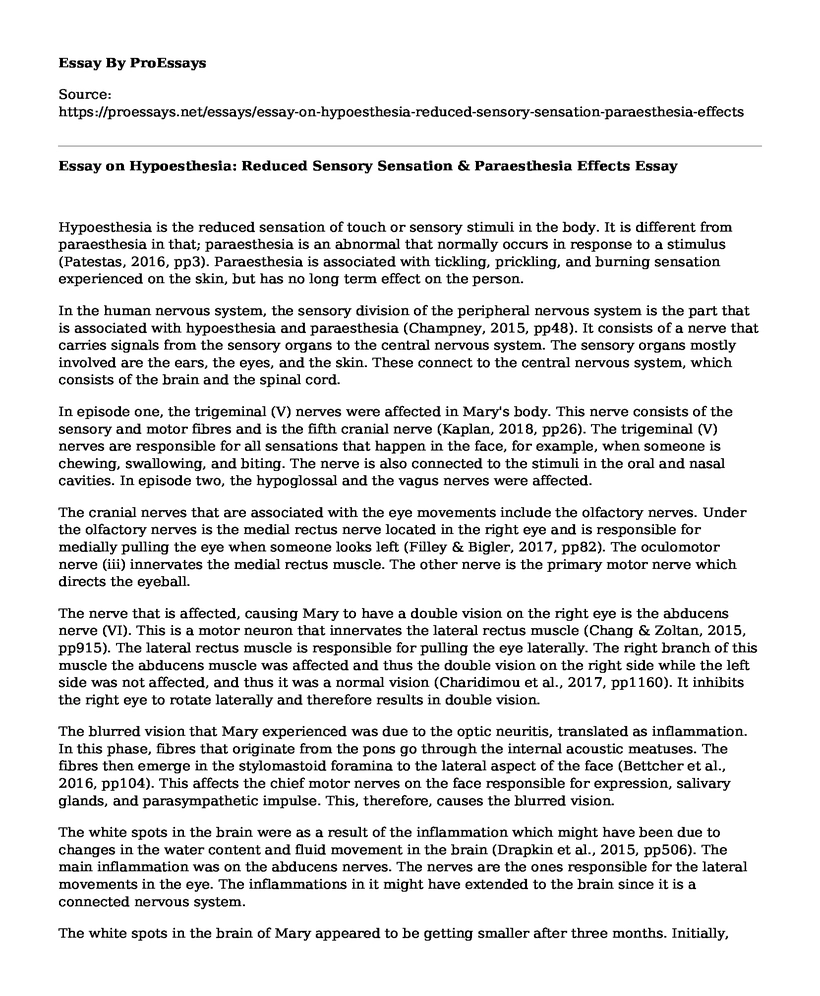Hypoesthesia is the reduced sensation of touch or sensory stimuli in the body. It is different from paraesthesia in that; paraesthesia is an abnormal that normally occurs in response to a stimulus (Patestas, 2016, pp3). Paraesthesia is associated with tickling, prickling, and burning sensation experienced on the skin, but has no long term effect on the person.
In the human nervous system, the sensory division of the peripheral nervous system is the part that is associated with hypoesthesia and paraesthesia (Champney, 2015, pp48). It consists of a nerve that carries signals from the sensory organs to the central nervous system. The sensory organs mostly involved are the ears, the eyes, and the skin. These connect to the central nervous system, which consists of the brain and the spinal cord.
In episode one, the trigeminal (V) nerves were affected in Mary's body. This nerve consists of the sensory and motor fibres and is the fifth cranial nerve (Kaplan, 2018, pp26). The trigeminal (V) nerves are responsible for all sensations that happen in the face, for example, when someone is chewing, swallowing, and biting. The nerve is also connected to the stimuli in the oral and nasal cavities. In episode two, the hypoglossal and the vagus nerves were affected.
The cranial nerves that are associated with the eye movements include the olfactory nerves. Under the olfactory nerves is the medial rectus nerve located in the right eye and is responsible for medially pulling the eye when someone looks left (Filley & Bigler, 2017, pp82). The oculomotor nerve (iii) innervates the medial rectus muscle. The other nerve is the primary motor nerve which directs the eyeball.
The nerve that is affected, causing Mary to have a double vision on the right eye is the abducens nerve (VI). This is a motor neuron that innervates the lateral rectus muscle (Chang & Zoltan, 2015, pp915). The lateral rectus muscle is responsible for pulling the eye laterally. The right branch of this muscle the abducens muscle was affected and thus the double vision on the right side while the left side was not affected, and thus it was a normal vision (Charidimou et al., 2017, pp1160). It inhibits the right eye to rotate laterally and therefore results in double vision.
The blurred vision that Mary experienced was due to the optic neuritis, translated as inflammation. In this phase, fibres that originate from the pons go through the internal acoustic meatuses. The fibres then emerge in the stylomastoid foramina to the lateral aspect of the face (Bettcher et al., 2016, pp104). This affects the chief motor nerves on the face responsible for expression, salivary glands, and parasympathetic impulse. This, therefore, causes the blurred vision.
The white spots in the brain were as a result of the inflammation which might have been due to changes in the water content and fluid movement in the brain (Drapkin et al., 2015, pp506). The main inflammation was on the abducens nerves. The nerves are the ones responsible for the lateral movements in the eye. The inflammations in it might have extended to the brain since it is a connected nervous system.
The white spots in the brain of Mary appeared to be getting smaller after three months. Initially, during the first three episodes, the protective insulating myelin sheath was damaged due to the inflammation that occurred in the abducens nerves (Charidiou et al., 2016, pp507). The spots became smaller because the inflammation ceased, and the axons become remyelinated in the lesion regions (Nestor et al., 2015, pp4). This, therefore, causes the water content in the brain to reduce and restores a balance in the fluid movement in the brain.
Works Cited
Bettcher, Brianne M., et al. "Neuroanatomical Substrates of Executive Functions: Beyond Prefrontal Structures." Neuropsychologia 85 (2016): 100-109.
Champney, Thomas H. Essential Clinical Neuroanatomy. John Wiley & Sons, 2015. 34-56
Chang, Bernard, and Zoltan Molnar. "Practical Neuroanatomy Teaching In the 21st Century." Annals of Neurology 77.6 (2015): 911-916.
Charidimou, Andreas, et al. "White Matter Hyperintensity Patterns In Cerebral Amyloid Angiopathy and Hypertensive Arteriopathy." Neurology 86.6 (2016): 505-511.
Charidimou, Andreas, et al. "MRI-Visible Perivascular Spaces In Cerebral Amyloid Angiopathy and Hypertensive Arteriopathy." Neurology 88.12 (2017): 1157-1164.
Drapkin, Zachary A., et al. "Development and Assessment of a New 3D Neuroanatomy Teaching Tool for MRI Training." Anatomical Sciences Education 8.6 (2015): 502-509.
Filley, Christopher M., and Erin D. Bigler. "Neuroanatomy for the Neuropsychologist." Textbook of Clinical Neuropsychology. Taylor & Francis, 2017. 62-90.
Kaplan-Solms, Karen. Clinical Studies in Neuro-Psychoanalysis: Introduction to a Depth Neuropsychology. Routledge, 2018. 1-34
Nestor, Paul G., et al. "Attentional Control and Intelligence: MRI Orbital Frontal Gray Matter and Neuropsychological Correlates." Behavioural Neurology, 2015 (2015). 1-10
Pasta, Maria A., and Leslie P. Gartner. A Textbook of Neuroanatomy. John Wiley & Sons, 2016.1-98
Cite this page
Essay on Hypoesthesia: Reduced Sensory Sensation & Paraesthesia Effects. (2023, Jan 26). Retrieved from https://proessays.net/essays/essay-on-hypoesthesia-reduced-sensory-sensation-paraesthesia-effects
If you are the original author of this essay and no longer wish to have it published on the ProEssays website, please click below to request its removal:
- Nursing Informatics Administrative Applications
- Article Review: The Causes of Crises and Appropriate Interventions for People with Dementia
- Diversity in the Nursing Workforce - Research Paper
- Exercise Plan for an Older Client With Coronary Heart Disease Paper Example
- Essay Example on Florence Nightingale: Pioneering the Science of Modern Nursing
- Immunization and Disease: An Urgent Debate - Essay Sample
- Paper Example on Proteins: The Building Blocks of Life and Their Essential Functions







